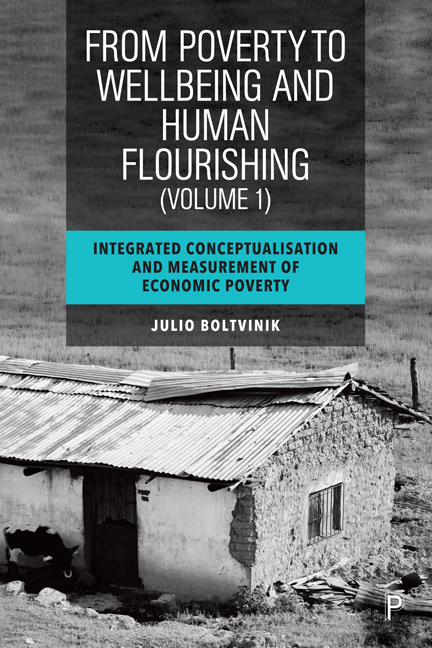 From Poverty to Well-Being and Human Flourishing
From Poverty to Well-Being and Human Flourishing 9 - Aggregate poverty measures (APM)
Published online by Cambridge University Press: 28 March 2024
Summary
9.1 Description and critique
In the study of poverty, it is necessary to distinguish between poverty measuring methods (PMM) and aggregate poverty measures (APM). Amartya Sen distinguishes between identification (who is poor and who is not) and aggregation, which makes it possible to obtain poverty indicators at the social level (how wide and deep social poverty is). To this I add an intermediate level, which can be called the poverty intensity measurement (PIM). PIM takes place at the same level at which identification is performed (individual/HH) and tells us how poor the poor are.
As Nolan and Whelan (1996, p 1) point out, the ‘value of sophisticated synthetical (or aggregated) measures is associated with the adoption, first of all, of a satisfactory approach to the identification of the poor, which has been relatively neglected’. Or, in even clearer terms, there is no point in calculating highly sophisticated aggregate measures of poverty if the method to identify the poor is flawed.
We have already addressed PMM in detail. It is now time to introduce the reader to the most widely used APM, including what I call the individual/HH PIM. In this chapter I seek to provide a personal vision of the usual measures, aiming at some degree of originality. At the end I present a new APM that incorporates social inequality in two variants: between poor and non-poor, and through the Gini coefficient (G) of the entire WB distribution.
I will begin by clarifying the problem of the observation unit. Conceptually, this comprises individuals who experience the deprivations related to poverty. Moreover, assuming that the degree of solidarity between the members of a HH and a family is limited, we must accept that there may be poor people in non-poor HH and non-poor people in poor HH. However, observing the distribution and use of resources within HH is almost impossible, so that for all practical purposes the HH – understood as the group of people who live under the same roof and share, at least, food expenses – becomes the usual unit of observation and identification of poverty.
- Type
- Chapter
- Information
- From Poverty to Well-Being and Human FlourishingIntegrated Conceptualisation and Measurement of Economic Poverty, pp. 188 - 212Publisher: Bristol University PressPrint publication year: 2023


